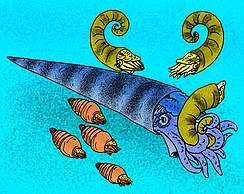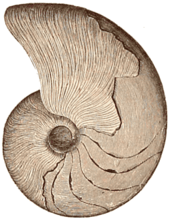Endocerida
Endocerida is an extinct nautiloid order, a group of cephalopods from the Lower Paleozoic with cone-like deposits in its siphuncle.
| Endocerida | |
|---|---|
 | |
| Scientific classification | |
| Kingdom: | Animalia |
| Phylum: | Mollusca |
| Class: | Cephalopoda |
| Subclass: | Nautiloidea |
| Order: | †Endocerida Teichert, 1933 |
| Families | |
|
† Proterocameroceratidae | |
Endocerida comprises a diverse group of cephalopods that lived from the Early Ordovician possibly to the Late Silurian. Their shells varied in form. Some were straight (orthoconic) others curved (cyrtoconic); some were long (longiconic), others short (breviconic). Some long-shelled forms like Endoceras attained shell lengths close to 6 metres (20 ft). The related Cameroceras is anecdotally reported to have reached lengths approaching 9 metres (30 ft), but these claims are problematic. The overwhelming majority of endocerids and nautiloids in general are much smaller, usually less than a meter long fully grown.
Morphology
Endocerids may have had a relatively small body chamber as well as a proportionally large siphuncle that in some reached nearly half the shell diameter, suggesting much of the visceral mass may have been housed within the siphuncle itself rather than just in the body chamber as with other nautiloids (Teichert, 1964). Endocerids are primarily distinguished by the presence of calcareous deposits, known as endocones, formed in the more apical portion of the siphuncle and thought to counterweight the animal’s body. The chambers (camerae) of endocerids are always free of organic deposits, unlike other orders such as the Michelinocerida and Actinocerida.
Body Size
Endocerids reached enormous body sizes. The largest confirmed specimen, belonging to Endoceras giganteum, is 3 metres (9.8 ft) long as preserved, but is missing a substantial portion of its aboral end.[3][4] The reconstructed length of the shell is nearly 6 metres (20 ft).[3][4] An alleged endocerid specimen 30 feet (9.1 m) long is unconfirmed.[3]
Ecology
The mode of life of endocerids is debated.[5] Endocerids may have been the apex predators of the Ordovician, probably living close to the sea floor, and preying on trilobites, molluscs, brachiopods and other bottom-dwelling organisms.[1] They were probably not active nektonic swimmers, but rather crawled over the floor of epicontinental seas or lay there in ambush. However, the extremely long, straight shells of endocerids would have made them slow and not very maneuverable, poorly suited for an active predatory role or a life near the sea floor.[5] Rather, endocerids may have been pelagic filter feeders, similar to other gigantic sea animals such as baleen whales and whale sharks.[5]
Reproduction
Endocerids laid relatively large eggs, and hatched at a relatively large body size.[6] It is likely that endocerids were demersal after hatching, as large eggs would make an easy target for predators in the pelagic zone.[6] Endocerids may have migrated from their habitat in the open ocean to shallower water to lay their eggs.[5]
Diversity
Endocerids were among some half a dozen cephalopod orders that appeared in the Lower Ordovician. They reached their greatest diversity during the Lower to Mid-Ordovician, but were already in decline by the middle of this period with most genera becoming extinct by the end of the Sandbian (late Ordovician), while some rare hangers on lasted into the Silurian.[2] In any case, the endocerid lineage became completely extinct relatively early on in cephalopod history.
Evolution
Endocerids evolved from the earlier ellesmerocerids, most likely from a genus similar to Pachendoceras. This ellesmerocerid gave rise to Proendoceras, the earliest representative of the Proterocameroceratidae and hence of the Endocerida. Endocerids evolved from ellesmerocerids by reduction of siphuncle diaphragms and the development of endocones. From that time, in the early middle Lower Ordovician, the Endocerida quickly diversified into different families. Two general evolutionary trends can be recognized. In one lineage, the siphuncle grew more complex, resulting in genera such as Chihlioceras and Allotrioceras. In the other lineage, overall size increased, resulting in such genera as Endoceras and Cameroceras.
Taxonomy and classification
Citing its diversity, Curt Teichert (1964) placed the Endocerida in its own subclass called the Endoceroidea or Endoceratoidea. (Some Russian paleontologists ranked it as a superorder instead). Rousseau Flower rejected this separation on the grounds that endocerids were no more diverse or complex than any other order and considered them simply another order within the Nautiloidea.
Flower (1958) divided the Endocerida into two suborders, the Proterocamerocerina and the Endocerina, which respectively follow the two primary evolutionary trends described above. As defined the Proterocamerocerina includes the Proterocameroceratidae, Manchurocheratidae, and Emmonsoceratidae; the Endocerina, the Piloceratidae and Endoceratidae.
See also
References
- Kröger, Björn; Yun-Bai, Zhang (2008). "Pulsed cephalopod diversification during the Ordovician". Palaeogeography, Palaeoclimatology, Palaeoecology. 273: 174–183. doi:10.1016/j.palaeo.2008.12.015.
- Barskov, I. S.; Boiko, M. S.; Konovalova, V. A.; Leonova, T. B.; Nikolaeva, S. V. (2008). "Cephalopods in the marine ecosystems of the Paleozoic". Paleontological Journal. 42 (11): 1167. doi:10.1134/S0031030108110014.
- Teichert, Curt; Kummel, Bernhard (1960). "Size of endoceroid cephalopods". Breviora. 128.
- Klug, Christian; De Baets, Kenneth; Kröger, Björn; Bell, Mark A.; Korn, Dieter; Payne, Jonathan L. (2015). "Normal giants? Temporal and latitudinal shifts of Palaeozoic marine invertebrate gigantism and global change". Lethaia. 48 (2): 267–288. doi:10.1111/let.12104.
- Mironenko, Aleksandr A. (2018). "Endocerids: suspension feeding nautiloids?". Historical Biology: 1–9. doi:10.1080/08912963.2018.1491565.
- Laptikhovsky, Vladimir; Nikolaeva, Svetlana; Rogov, Mikhail (2018). "Cephalopod embryonic shells as a tool to reconstruct reproductive strategies in extinct taxa". Biological Reviews. 93 (1): 270–83. doi:10.1111/brv.12341. PMID 28560755.
Further reading
- Clarke, J.M. 1897. The Lower Silurian Cephalopoda of Minnesota. In: E.O. Ulrich, J.M. Clarke, W.H. Scofield & N.H. Winchell The Geology of Minnesota. Vol. III, Part II, of the final report. Paleontology. Harrison & Smith, Minneapolis. pp. 761–812.
- Flower, 1955, Status of Endoceroid Classification; Jour. Paleon. V 29. n.3 May 1955,pp 327–370; figs, plts.
- Flower,1958, Some Chazyan and Mohawkian Endoceratida; Jour. Paleon V32, n.3,pp 433–468; figs, plts.
- Flower, 1976, Ordovician Cephalopod Faunas and Their Role in Correlation, in Bassett,M.C.(Ed); The Ordovician System: Proceedings of a Paleontological Association Symposium; Birmingham,Eng.1974; Univ of Wales and Welsh Nat’l Mus Press.
- Teichert, C. 1964, Endoceratoidea, in the Treatise on Invertebrate Paleontology, Part-K (Nautiloidea; Geol Soc of America and University of Kansas Press; pp K160–K188; figs.
- Neale Monks and Philip Palmer. Ammonites. Smithsonian Institution Press, Washington D.C. 2002.
